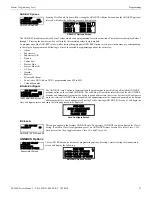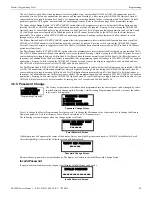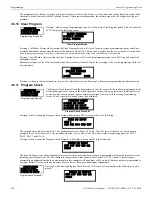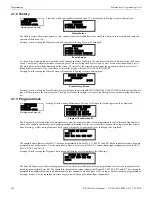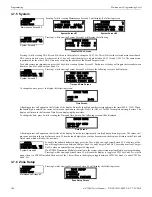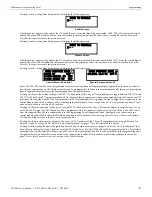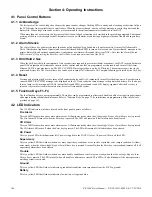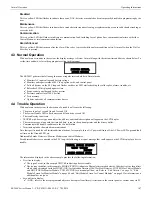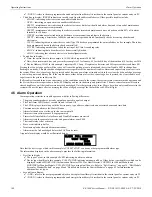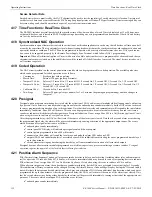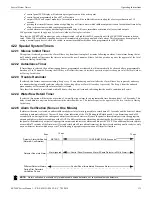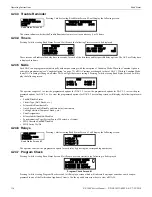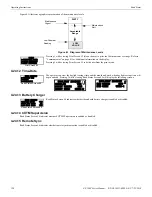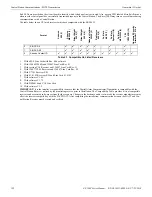
108
ES-200X Series Manual —
P/N LS10131-000FL-E:C 7/25/2018
Operating Instructions
Alarm Operation
<NOUN>; refers to the user programmed noun descriptor from library list resident in the control panel or custom entry via PC.
•
Third line in display:
INVREP
indicates an invalid reply from the addressable device. Other possible troubles include:
–
SHORT
- indicating a shorted circuit on an addressable device
–
OPEN
- indicating an open circuit on an addressable device
–
DIRTY1
- maintenance alert indicating that a detector is near but below the allowed alarm limit and is in need of maintenance
before the performance is compromised
–
DIRTY2
- maintenance alert indicating that a detector needs immediate maintenance since it has been within 80% of its alarm
threshold for 24 hours
–
INVREP
- maintenance alert indicating a hardware or communication problem in the detector
–
TEST F
- indicating a detector has failed the automatic test operation which functionally checks its sensing chamber and
electronics
–
INV ID
- indicating that an incorrect device code (Type ID) has been programmed for an installed device (for example, Photo has
been programmed but an Ion detector has been installed)
–
SW TBL
- indicating a module has failed the testing of its Class A switching relay
–
BLOCK
- indicating that a beam detector’s beam is totally blocked
–
ALIGN
- indicating that a beam detector is in beam alignment mode
•
Fourth line in display:
Time; the current time in this example is
10:00A
which represents 10:00 AM
Date; the current month, day and year in this example is
01
for January,
08
for the 8th day of the month and
16
for the year 2016
Device Address;
1D001
in this example
1
represents SLC Loop,
D
represents a detector and
001
represents device address 001
Pressing the
Acknowledge
or
Alarm Silence
key will cause the pulsing piezo to silence and the system Trouble LED to change from
flashing to on steady. This block acknowledgment occurs regardless of the number of troubles, alarms and supervisory events active in
the system. When the
Acknowledge
key is pressed and at least one new alarm or trouble exists in the system, the ‘acknowledge’ message
is sent to the printer and history file. If the trouble clears, either before or after the
Acknowledge
key is pressed, the ‘clear trouble’ mes-
sage is sent to the printer and history file.
If all troubles clear and there are no supervisory or fire conditions active in the system, the system returns to normal mode operation and
the
System Normal
message is shown on the LCD display and sent to the history and printer files. The auto-restore feature will restore
cleared troubles even if the troubles were never acknowledged. Note that pressing the
Alarm Silence
key when only troubles exist in the
system will have the same effect as pressing the
Acknowledge
key except the Alarm Silenced LED will light.
4.5 Alarm Operation
Alarm operation is similar to trouble operation with the following differences:
•
The piezo sounder produces a steady output as opposed to a pulsed output
•
The Fire Alarm LED flashes 1 second On and 1 second Off
•
The LCD displays
Alarm
along with the device name, type, address, adjective/noun, associated zones and time/date
•
Communicate the alarm to the Central Station
•
Alarms latch and
are not allowed to clear automatically
•
Alarms activate software zones if so programmed
•
Timers for Silence Inhibit, Autosilence, and Trouble Reminder are started
•
Alarms activate the general alarm relay and general alarm zone Z000
•
The trouble relay is not activated
•
Store event in history buffer
•
Terminate upload or download communications
•
Alarms must be Acknowledged before the FACP can be reset
A typical alarm display would be as illustrated below:
Note that the device type, which in this example is
PULL STATION
, can be any other programmable alarm type.
The information displayed in the above example provides the following information:
•
First line in display:
The type of event; in this example
ALARM
indicating an alarm condition
Device type identifier; in this example,
PULL STATION
indicates a manual pull box. Other device type identifiers which can be
displayed include
SMOKE (ION)
for Ionization Detector,
HEAT
for Heat Detector,
CONTROL
for Control Module and
MONITOR
for Monitor Module,
PULL STATION
for a manual pull box, etc. Refer to
Screen for Monitor Module” on page 60 and “Edit Module Screen for Control Modules” on page 65 for information on
additional device types.
•
Second line in display:
<ADJ>; refers to the user programmed adjective descriptor from library list resident in the control panel or custom entry via PC.
<NOUN>; refers to the user programmed noun descriptor from library list resident in the control panel or custom entry via PC.
ALARM PULL STATION
<ADJ> <NOUN>
Z000
10:00A 010816 1M001




